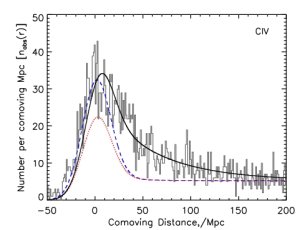 |
|
Fig. 1:
From Li, Hernquist, Robertson et al., 2007, ApJ
665:187. Simulations of QSO feedback, which removes all the gas from
the host galaxy of the QSO preventing subsequent star formation and
black hole growth, are successful in reproducing many observational
results. But can we find direct observational evidence for such
efficient and ubiquitous feedback?
Credit: Pierre Kervella (Paris-Meudon Observatory) and European Southern Observatory
|
 |
 |
|
Fig. 2:
The number of MgII absorption line systems observed around
QSOs, as a function of distance from the QSO, normalised by the number
of absorbers that would be expected if absorbers did not cluster
around QSOs. We observe the same clustering signal seen in
galaxy-galaxy clustering, with an amplitude consistent with absorbers
originating in typical massive galaxies.
|
 |
 |
|
Fig. 3:
The number of CIV absorption line systems observed, along
the line-of-sight from a QSO (histogram). The central peak could be
explained by galaxy clustering, but not the high velocity
tail. Overplotted in black is our best-fit model which suggests that
40% of CIV absorbers observed to be within 170Mpc of the QSO are
actually intrinsic to the QSO and its host galaxy.
|
|  |
Absorption lines in QSO spectra have been studied since QSOs were
first observed with spectrographs. They appear as black regions
against the background light of the QSO, and their observed
wavelengths tell us they are caused by chemical elements situated
between the QSO and the Earth. In general these elements lie in
ordinary gas clouds: the denser and more metal rich clouds lie close
to, or within, galaxies; and the more diffuse, metal poor clouds lie
alone in "voids", regions with no galaxies. But it has always been a
possibility that some of the absorption lines may be directly
associated with the QSO itself - they may be the evidence we have been
searching for that the QSO is expelling the gas from the galaxy in
which it lives.
Indeed, we do observe an increase in the number of these absorbers
close to the QSO. However, because absorbers are also caused by
ordinary galaxies, and galaxies tend to live together in groups, this
peak may simply be explained by ordinary galaxies in the QSOs
neighbourhood and thus be of no relevance to the search for
outflows. A simple test, performed by Vivienne Wild and her
collaborators, is to measure directly the clustering of absorbers
around QSOs, by looking for absorbers next to the QSO i.e. using
background QSOs as probes of the environment around foreground
QSOs. The result is shown in Figure 2 for singly ionised Magnesium
(MgII): we detect the clustering of absorbers around QSOs and show
that it follows exactly the same powerlaw as for ordinary
galaxy-galaxy clustering. However, there is a surprise when we
translate the MgII clustering signal into a prediction for the number
of absorbers along the line-of-sight between the QSO to us. We
massively overpredict the number of absorbers: we can conclude that
the ionising radiation of the QSO affects the gas clouds in and/or
around most nearby galaxies, ionising it beyond the levels normally
experienced by such clouds.
Therefore, we must look at absorption lines with a higher ionisation
state to search for outflowing gas. Performing the same experiment for
triply ionised Carbon atoms (CIV), we see a very different picture
(Figure 3): an excess of absorbers which can only be caused by gas
flowing towards us fast from the QSO. We find that around 40% of
absorbers close to the QSO are infact truly associated with the QSO,
with a range of velocities from a few hundred to many thousands of
kilometers per second.
Are these absorbers the evidence we have been searching for, that QSOs
expel a large fraction of the gas from the galaxies in which they
live? Unfortunately, it has become clear that the QSO has a
considerable ionising effect on the gas clouds of its own
galaxy. Combining this unknown ionisation state with the unknown
distance of the clouds from the QSO, it is impossible to measure the
mass of the clouds which are being expelled at such speeds. In the
near future, we hope that further constraints will be placed on the
true nature of these clouds by measuring the strengths and widths of
other absorption features from other elements that are present in the
QSO spectra.
Vivienne Wild, Guinevere Kauffmann, Simon White
Publications
Vivienne Wild, Guinevere Kauffmann, Simon White et al.,
"Narrow associated QSO absorbers: clustering, outflows and the line-of-sight proximity effect",
2008, submitted to MNRAS,
 arXiv:0802.4100 arXiv:0802.4100
|




